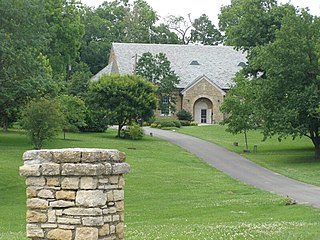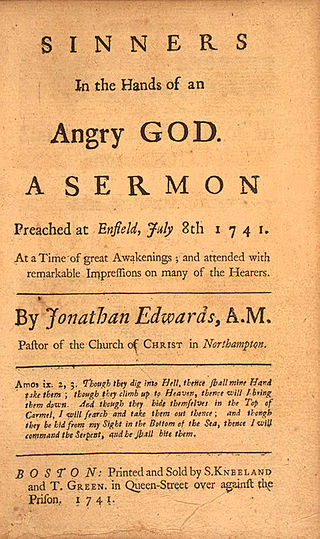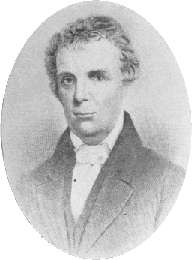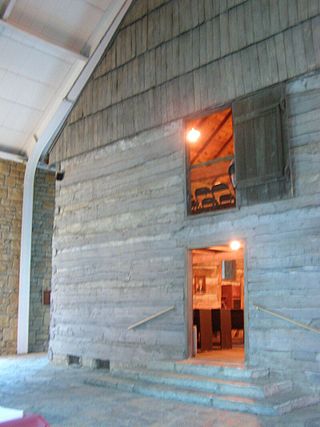Related Research Articles

The Christian Church is a mainline Protestant Christian denomination in the United States and Canada. The denomination started with the Restoration Movement during the Second Great Awakening, first existing during the 19th century as a loose association of churches working towards Christian unity, then slowly forming quasi-denominational structures through missionary societies, regional associations, and an international convention. In 1968, the Disciples of Christ officially adopted a denominational structure at which time a group of churches left to remain nondenominational.

The Second Great Awakening was a Protestant religious revival during the early 19th century in the United States. The Second Great Awakening, which spread religion through revivals and emotional preaching, sparked a number of reform movements. Revivals were a key part of the movement and attracted hundreds of converts to new Protestant denominations. The Methodist Church used circuit riders to reach people in frontier locations. The Second Great Awakening led to a period of antebellum social reform and an emphasis on salvation by institutions. The outpouring of religious fervor and revival began in Kentucky and Tennessee in the 1790s and early 1800s among the Presbyterians, Methodists and Baptists.

Charles Grandison Finney was an American Presbyterian minister and leader in the Second Great Awakening in the United States. He has been called the "Father of Old Revivalism." Finney rejected much of traditional Reformed theology, teaching that people have complete free will to choose salvation.

The Cumberland Presbyterian Church is a Presbyterian denomination spawned by the Second Great Awakening. In 2019, it had 65,087 members and 673 congregations, of which 51 were located outside of the United States. The word Cumberland comes from the Cumberland River valley where the church was founded.
The Old Regular Baptist denomination is one of the oldest in Appalachia with roots in both the Regular and Separate Baptists of the American Colonies and the Particular Baptist of Great Britain. This group has seen a marked decline in its membership during the last two decades. The Old Regular Baptist Faith and order with her many branches and factions still remains the dominant Faith in some rural Central Appalachian Counties along or near the Kentucky Virginia border.
John Taylor (1752–1833) was a pioneer Baptist preacher, religious writer, frontier historian and planter in north and central Kentucky. His two histories of early Baptist churches in Kentucky provide insight into the frontier society of the early decades of the 19th century. His 1820 pamphlet entitled "Thoughts on Missions" put him at the center of the controversy within frontier Baptist congregations about supporting mission societies. In buying and selling land on the frontier, Taylor acquired 2,000 acres (8.1 km2) and 20 African-American slaves by the end of the first decade of the 19th century, thus entering the planter class.

Cane Ridge was the site, in 1801, of a huge camp meeting that drew thousands of people and had a lasting influence as one of the landmark events of the Second Great Awakening, which took place largely in frontier areas of the United States. The event was led by eighteen Presbyterian ministers, but numerous Methodist and Baptist preachers also spoke and assisted. Many of the "spiritual exercises", such as glossolalia and ecstatic attendees, were exhibited that in the 20th century became more associated with the Pentecostal movement.

The camp meeting is a form of Protestant Christian religious service originating in England and Scotland as an evangelical event in association with the communion season. It was held for worship, preaching and communion on the American frontier during the Second Great Awakening of the early 19th century. Revivals and camp meetings continued to be held by various denominations, and in some areas of the mid-Atlantic, led to the development of seasonal cottages for meetings.

The First Great Awakening or the Evangelical Revival was a series of Christian revivals that swept Britain and its thirteen North American colonies in the 1730s and 1740s. The revival movement permanently affected Protestantism as adherents strove to renew individual piety and religious devotion. The Great Awakening marked the emergence of Anglo-American evangelicalism as a trans-denominational movement within the Protestant churches. In the United States, the term Great Awakening is most often used, while in the United Kingdom the movement is referred to as the Evangelical Revival.

Barton Warren Stone was an American evangelist during the early 19th-century Second Great Awakening in the United States. First ordained a Presbyterian minister, he and four other ministers of the Washington Presbytery resigned after arguments about doctrine and enforcement of policy by the Kentucky Synod. This was in 1803, after Stone had helped lead the mammoth Cane Ridge Revival, a several-day communion season attended by nearly 20,000 persons.

The Carroll Lee Cropper Bridge is a continuous steel arch-shaped truss bridge over the Ohio River between Indiana and Kentucky. Built between 1968 and 1977, the four-lane arched truss span provides a western Ohio River crossing for the Interstate 275 beltway around the Cincinnati area. The section of Interstate 275 on the Cropper bridge is the only Interstate highway in the Cincinnati, Ohio area that goes between Indiana and Kentucky.

The Red River Meeting House was the site of the first religious camp meeting in the United States. Held June 13–17, 1800, it marked the start of the Second Great Awakening, a major religious movement in the United States in the first part of the nineteenth century. The meeting was organized by the Presbyterian minister James McGready in Logan County, Kentucky, and several preachers took part.

The Cane Ridge Revival was a large camp meeting that was held in Cane Ridge, Kentucky, from August 6 to August 12 or 13, 1801. It has been described as the "[l]argest and most famous camp meeting of the Second Great Awakening." This camp meeting was arguably the pioneering event in the history of frontier camp meetings in America.

As of the 2010 census, the United States Commonwealth of Kentucky had an estimated population of 4,339,367, which is an increase of 297,174, or 7.4%, since the year 2000. Approximately 4.4% of Kentucky's population was foreign-born as of 2010. The population density of the state is 107.4 people per square mile.
The Brush Run Church was one of the earliest congregations associated with the Restoration Movement that arose during the Second Great Awakening of the early 19th century. In 1811, a congregation of Christian reformers known as the Christian Association of Washington (Pennsylvania) reconstituted itself as a church and constructed a new building to replace the temporary log building where they began. Because it was built on the farm of William Gilchrist, near a stream called Brush Run, both the building and the congregation became known as Brush Run Church. It was the center of activity for Thomas and Alexander Campbell, father and son respectively, in their movement for Christian reform on the American frontier. The meeting house was later used as a blacksmith shop, then as a post office and finally it was moved to Bethany, Virginia.
Rev. James McGready (1763–1817) was a Presbyterian minister and a revivalist during the Second Great Awakening in the United States of America. He was one of the most important figures of the Second Great Awakening in the American frontier.

David Purviance, November 14, 1766 – August 19, 1847, was a member of the Kentucky legislature, a member of the Ohio legislature, and an important early leader in the Stone-Campbell Restoration Movement. He was also an early trustee (1819–1836) of Miami University in Oxford, Ohio and often served as its president pro tempore.

Cane Ridge Meeting House is a historic church building on Cane Ridge near Paris, Kentucky built in 1791. It is one of the oldest church buildings in Kentucky and the largest one room log structure. The church was the site of a large frontier Christian revival in 1801 hosted by the local Presbyterian congregation that met in the building. Nearly 10,000 people attending. According to the museum "[i]n 1804, a small group of Presbyterian ministers from Kentucky and Ohio... penned and signed a document, "The Last Will and Testament of the Springfield Presbytery", at Cane Ridge that resulted in the birth of a movement seeking unity among Christians along non-sectarian lines. They would call themselves simply "Christians. The Christian Church, the Churches of Christ (non-instrumental), and the Christian Churches (independent) of the Stone-Campbell movement trace their origins here. This movement is often noted as the first one indigenous to American soil." In the 1930s a stone building was constructed around the original log structure. The church is still used for worship.

Christian revivalism is increased spiritual interest or renewal in the life of a church congregation or society, with a local, national or global effect. This should be distinguished from the use of the term "revival" to refer to an evangelistic meeting or series of meetings. Proponents view revivals as the restoration of the church itself to a vital and fervent relationship with God after a period of moral decline.
The Revival of 1800, also known as the Red River Revival, was a series of evangelical Christian meetings which began in Logan County, Kentucky. These ignited the subsequent events and influenced several of the leaders of the Second Great Awakening. The events represented a transition from British traditions to innovations arising from the unique needs and culture of Americans in the new century, especially on the frontier. The startling manifestations of revival fervor that first occurred in June 1800 at the Red River Meeting House, a small Presbyterian congregation led by James McGready, began as a Scottish sacrament service, but led to the important innovation of serial religious services later known as camp meetings.